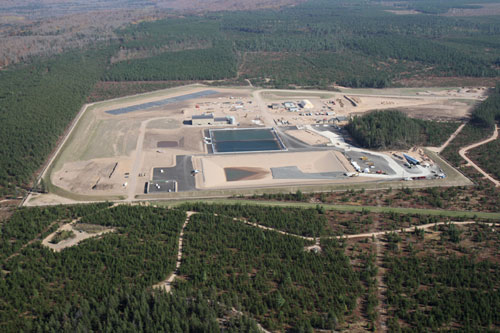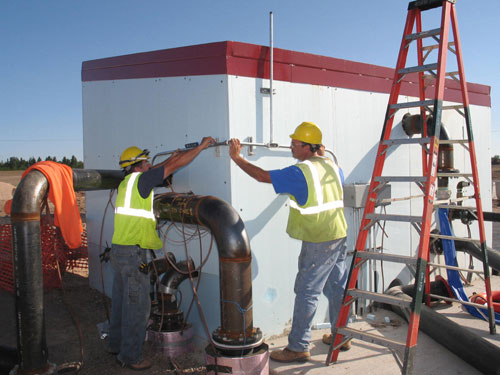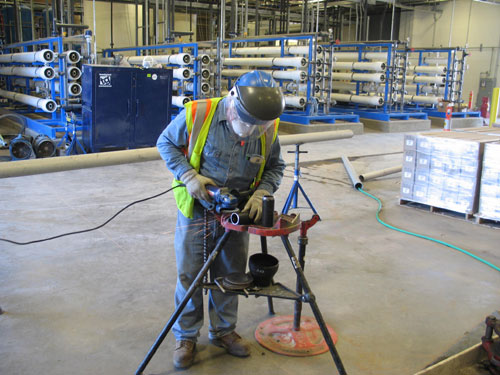Trades enjoy jobs boom from remote Kennecott nickel mine
Date Posted: October 21 2011
MARQUETTE – A new chapter in the Upper Peninsula’s rich mining history is being written on a site 26 miles northwest of here on an area called the Yellow Dog Plains.
On a remote plot of land near Big Bay village, the building trades are in the process of setting up North America’s only mine devoted primarily to nickel extraction. By the time the mine is closed and turned back over to Mother Earth in seven or eight years, some 300 million pounds of nickel will have been extracted, along with about 250 million pounds of copper. Much smaller portions of other metals will also be removed.
“It’s a huge project for the area, and it’s already a major jobs creator for construction workers,” said Daniel Blondeau, Advisor – Communications and Media Relations for Kennecott Eagle Minerals, which is operating the mine under the parent company, Rio Tinto. “When we finish here, by permit we will restore the area to its original state and take out everything that traces back to it being a mine.”
The $469 million Eagle Project is indeed a major jobs creator for the building trades. Boldt Construction is the prime contractor on the project. Along with their subcontractors, they will put to work about 500 construction workers. And during the years of the mining, 220 operational jobs will be created.
As isolated as it is, the mining site created a number of challenges during the set-up phase, including transportation and power delivery. The site is accessible from an old but improved dirt logging road that’s about a half hour’s drive from the nearest paved road.
Electrical delivery to the site also had to be improved. Kennecott paid $8 million for the replacement of miles of existing 50-year-old power lines on the public grid that leads from a substation at the Wisconsin Energies’ Presque Isle Power Plant in Marquette to the new mine. The new power lines, not surprisingly, have also helped make power delivery to homes and businesses in the region more dependable.
The mine site itself is basically a big clearing in a forest that contains a mixture of fixtures and features you’d see in any city or only on a… nickel mine. The site sits on approximately 120 acres (a typical 18-hole golf course takes up 150-180 acres of land). Many Hardhats are bussed in to the mining site from Marquette as a convenience and in order to minimize road traffic.
“The construction work at the mine came at a perfect time for us,” said Tony Retaskie, executive director of the Upper Peninsula Construction Council. “Many of the people working on site hadn’t had a steady job in two years. So it has been great for them to have an opportunity to build up their bank accounts and get their health insurance back. And it’s been nice for a lot of local unions to start getting money flowing back into their apprenticeship training programs.”
Kennecott lists a number of structures planned for the site, and most are already complete. A truck wash building will clean all trucks leaving the mine site, and the wash water will be treated and recycled. The site will also have a water treatment plant, pump houses, a treated water infiltration system, a powerhouse, a services building, and contact water basins.
The entire site is sloped so that the basins, which have a multi-layered waterproof lining and a leak detection system, collect water that comes in contact with mining operations. The water is then treated and used for washing trucks, mining activities, or slowly released back into the environment. Kennecott says its goal “is to ensure that area groundwater, streams, rivers and lakes remain protected from activities associated with mining.” An onsite water treatment plant will purify water used during operations, as well as rain and snow.
Environmentalists had numerous concerns about the construction of the mine, but were fixated on whether the water used in the mining process would contaminate the groundwater. Much of the work of the building trades has been focused on building plumbing systems that will make sure Kennecott meets or exceeds all state and legal requirements for construction, mining and natural reclamation of the site.
Rio Tinto and their Kennecott Eagle Project have not only brought jobs to the area – they have introduced a safety culture that’s likely the most stringent the building trades have ever seen. For example, vehicles on site are required to chock their wheels no matter the grade, and beep twice when backing up. And that’s just for starters – there are many more requirements for trades workers. “Health, safety and the environment is something we think about every day, and it’s part of everyone’s job at Kennecott,,” Blondeau said. “Wherever Rio Tinto operates, the health and safety of our employees and environmental protection is a core value.”
Retaski said he had talked to workers and union reps about the enhanced safety requirements, “and they’re not a problem. People have accepted them. They’re really a plus on this job, and the nice thing is, our people are going to bring what they’ve learned about safety to future jobs.”
Most construction at the site will be complete by the end of 2012. Mining operations are expected to start in 2013.
The Kennecott Mine’s operations centers around its portal into the underground that will provide access to the nickel and copper that are there. Their geologists expect the mining operations to unearth a highly concentrated nickel ore body roughly six acres in size underground.
The portal is basically a ramp that will allow machines to bore a zig-zag tunnel ever-deeper into the ground. The bottom of the ore body lies approximately 984 feet below the surface. Called “long-hole stope” mining, the process requires a main decline tunnel for worker and equipment access, a primary ventilation system and an emergency route to the surface. Stopes are horizontal, open spaces created as ore is removed. After stopes are mined they are filled with excess waste rock to maintain the integrity of the ground before another stope is created.
Nickel and copper are increasingly in demand in the world’s economy, used in the manufacture of cell phones, hybrid-electric car batteries and refrigerators. Sixty percent of all nickel that’s mined in the world is used for stainless steel.
Kennecott’s mining operations in the area also include the Humboldt Mill, which processed iron ore and other metals beginning in the 1950s but has been unused for the last two decades. Located about 60 miles from the Yellow Dog Plains site, it is being renovated as part of the mining operations. Ore that is taken from the mining site will be trucked to the mill and crushed and separated into nickel-copper concentrate. The material will then be taken by rail to a smelter and further concentrated.
At the end of the mining process, all excess rock will be returned underground and the site will be reclaimed by nature. Kennecott must monitor water quality for 20 years after closure.

LOCATED ON ABOUT 120 acres in the Upper Peninsula, the Kennecott Eagle Mine has been a major employer for the building trades. Contact water basins, which are square-shaped in the center of the site, collect and hold water at the site for treatment. The mine’s portal to the underground is visible by a silver tube at the lower right of the site, in front of the trees.

OUTSIDE OF A PUMPHOUSE at the Kennecott Eagle Mine, IBEW Local 1070 electricians Paul Simms and Joe Helm set conduit for an outside receptacle. They’re working for M.J. Electric.

GRINDING A SECTION of pipe at the Kennecott Mine’s water treatment plant is Scott Rady of Plumbers and Pipe Fitters Local 111, working for Tweet & Garot. Behind him are racks of pipe that are the heart of the mine’s reverse osmosis system for treating water.
